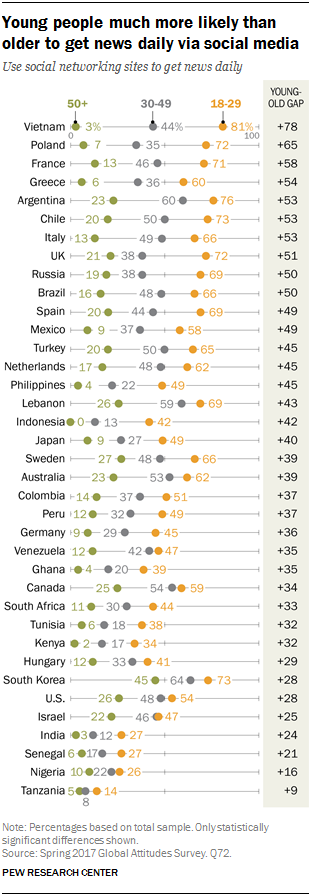
While access to digital technology is increasingly common, the use of the web generally, as well as social media in particular, for getting news still varies considerably across countries. In 14 of the 38 countries studied, at least half of adults use the internet to get news daily. This is true of social media and news use in just three countries.
With few exceptions, age, education level and income connect closely to online and social media news use.
People in wealthier countries more likely to get news online
Across countries, a global median of 42% say they use the internet to get news at least once a day (either once a day or several times a day). Another 20% go online less than once a day to get news and 35% say they never do so.
Online news use varies considerably by country-level wealth. People in advanced economies (median of 54%) are much more likely to get news online at least once a day than people in emerging or developing economies (23%; for more details on the economic categorization, please see Appendix C).
South Korea and Sweden have the highest percentage of adults who get news online daily (80% and 70% respectively). It is less common in the United States (59%), though nearly half of the American public goes online to get news several times a day (46%).
Tanzania, one of the poorest nations surveyed, has the lowest percentage that accesses the internet daily for news (11%).

People in poorer countries just as likely to use social media for news as those in wealthier countries
A global median of 35% say they use social media to get news daily, while 13% use it less than once a day to get news. About half (52%) say they never use social networking sites to get news.
Compared with internet use for news – where the relationship between national economic status and online news use is evident – social media news use is not strongly related to country-level wealth. People in advanced economies (median of 36%) use social media daily for news at similar rates to those in emerging or developing economies (33%).
Daily online use of social networking sites for news is highest in South Korea (57%), Lebanon (52%) and Argentina (51%).
And, similar to getting news online more generally, only one-in-ten Tanzanian adults use social networking sites to get news daily.

Within countries, younger, highly educated and wealthier people more likely to get news using social media
In almost all countries surveyed, people who are younger, are more highly educated and have a higher income are more likely than their counterparts to use social networking sites to get news daily.
In 37 of the 38 countries studied, adults ages 18 to 29 are more likely than those 50 and older to use social media at least once a day for news. In 10 countries, the gap is at least 50 percentage points, with the largest differences in Vietnam (78 points) and Poland (65 points).
In several countries, accessing news through social networking sites is almost exclusively an activity of the young. In Vietnam, for example, 81% of people ages 18-29 use social media daily to access news, while only 3% of those ages 50 and older do so. In Poland, Mexico, and Greece, over half of 18- to 29-year-olds use social media this way, compared with about 10% or less of those ages 50 and older.
In most countries, less than a quarter of the population ages 5o and older reports using social media daily for news. One notable exception is South Korea, where 45% of people 50 and older use social networking sites daily to access news.

Greater use of social media for news is not only more common among the young but also among the more highly educated. In 35 of the 38 countries studied, people with a higher level of education are more likely to use social networking sites to get news daily than those with less education.
Developing and emerging economies tend to have the largest education gaps in accessing the news on social media. Differences of at least 40 percentage points arise in Vietnam, Kenya, Brazil, Ghana, Turkey and Chile. The United States and Israel, both advanced economies, have some of the smaller education gaps, while there is no significant education difference in Germany, Sweden and the Netherlands.
Even though country-level wealth is not related to social media news use, individual-level income is. In 32 of the 38 countries surveyed, higher-income people are more likely than those with lower incomes to use social media daily for news.2
Vietnam, Peru and Israel have the largest income gaps, with differences of at least 25 percentage points. By comparison, the U.S. and Canada have smaller income gaps (8 points).
The survey finds similar differences by age, education and income when it comes to daily internet news use. Additional detailed tables on both questions are available in Appendix A.




